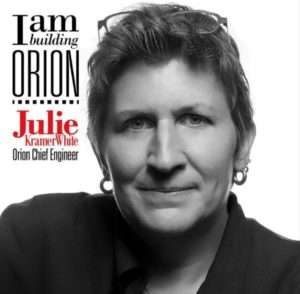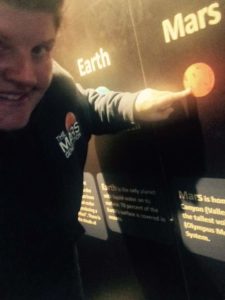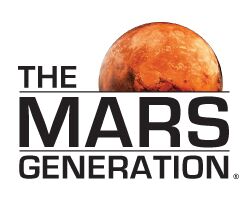We are so lucky to have Caroline Geraghty join us as a guest writer. Please scroll to the bottom of this post to learn more about Caroline.
Please visit our “Get Involved” page to learn more about how you can volunteer and/or join The Mars Generation. Let’s go to Mars!
*** Please note guest submissions are options of the author and do not necessarily reflect the mission or beliefs or The Mars Generation.
Introduction
The fields of aer ospace engineering and technology are constantly evolving. It’s been almost half a century since humans first stepped foot on the Moon, a feat many thought impossible. Now, humanity is pushing the boundaries of space exploration even further: we are pursuing Mars.
ospace engineering and technology are constantly evolving. It’s been almost half a century since humans first stepped foot on the Moon, a feat many thought impossible. Now, humanity is pushing the boundaries of space exploration even further: we are pursuing Mars.
In 2003, NASA launched the Mars Exploration Rover Opportunity which landed on its target destination in 2004. Since then, NASA has been collecting data from Mars about water activity, soil, and temperature. This is just one step of many in the quest to send humans to Mars.
More recently, NASA is building the Orion, a spacecraft designed to take humans to the moon and beyond. NASA is currently constructing Space Launch System (SLS) which is the rocket that will launch Orion to deep space.
I, Caroline Geraghty, had the opportunity to speak with NASA’s Chief Engineer Julie Kramer-White about her rewarding career at NASA and the origin of Orion.
Interview
1. What inspired you to go into space engineering?
There was a big push in the U.S. in the 1970’s to encourage girls in math and science. I had an aptitude in both, so was encouraged to consider either medicine or engineering by several of my teachers. I didn’t know any aerospace engineers growing up in Indiana. The only aerospace engineer I knew was Scotty on Star Trek! But I definitely knew I wasn’t just interested in engineering.
I wanted to work at NASA on human spaceflight programs. That was the early Space Shuttle Program, before the Challenger accident. In fact, the biography accompanying my senior picture in my high school yearbook says I intend to work at NASA. Luckily, NASA and Purdue, the university I attended, had a long history together…I was recruited into Purdue’s co-operative education (student intern) program with NASA in 1986, and I’ve been at NASA ever since.
2. How did NASA’s Orion come about? When and where did the project get started?
Orion became an official program around 2006 with the selection of Lockheed Martin as the program’s prime contractor. There was work (requirements, design-concept work, etc.) that predates that, but let’s call that the official beginning of the program. Orion, or CEV (Crew Exploration Vehicle) as it was called at the time, was intended to fill the void in U.S. human spaceflight capability that would come when the Space Shuttle program ended (it would have been over 20 years old at that point). Furthermore, Orion was designed to allow for exploration beyond low Earth orbit.
Shuttle was a magnificent piece of engineering, but was intended specifically for low Earth orbit. Its wings and payload bay, which gave it the capabilities to land on a runway and haul heavy, large payloads to orbit, were not practical from a mass or reentry perspective for going beyond low Earth orbit.
Getting beyond LEO, as we call low Earth orbit, is all about mass. If your spacecraft is too heavy, you won’t get out of the earth’s gravitational influence, let alone have the performance to get to the Moon or beyond. For every pound of spacecraft that you take to the Moon or Mars, you need many pounds of propellant, so the problem compounds pretty quickly.
Also, one of the things we learned over time was that a side-mounted spacecraft, like the Shuttle, was less desirable from a crew safety perspective. It would always be vulnerable to debris or ice shed from the stack. So, all the new spacecraft designs are top mounted. This allows the use of crew escape systems which can push or pull the capsule to safety in the event of a problem with the launch vehicle.
3. December 5th, 2014, saw the first trial flight [of Orion] which ended with a splashdown in the Pacific ocean. This must’ve been an amazing event to see happen successfully.
Of course a lot of us had invested a tremendous amount of time and energy into the program at that point, and the Space Shuttle had been retired for about 2.5 years. So, we were very excited to get to launch. We had a lot of confidence in the engineering and checkout that had been put in the vehicle, so we expected it to be successful. However, this test flight was so successful that I would have to say: even we were a little surprised at exactly how successful it was. We flew a test flight to stress the vehicle and its systems, so we could learn as much as possible before we fly astronauts on Orion. And it performed exceptionally well under those conditions.
4. With vigorous tests being carried out on the craft, and most recently, the successful live testing of the Abort module, what testing plans should we expect to see next?
We have several different tests at the component and subsystem levels ongoing. For example, our final qualification drop tests of our parachute system and our integrated avionics and software lab are going on right now…The EM-1 (Exploration Mission 1) spacecraft is being built right now, and will soon power on for the first time. We will add the European Service module in the spring, test the two together and then send the stack to Plum Brook Station near Cleveland Ohio in the U.S. for testing in their big thermal vacuum chambers. This will simulate the harsh environment in space and ensure that the spacecraft thermal conditioning systems are working before we send it out into deep space.
At the same time we have the spacecraft in testing at Plum Brook, we will be conducting our second and final integrated ascent abort test, Ascent Abort-2. We conducted an “off the pad” abort test in 2010, and this companion test will demonstrate abort system capability in the transonic region. This high altitude test represents the design condition for controlling the abort vehicle. So, we need to demonstrate that our guidance systems and motors are effective for aborting off the launch vehicle if there were ever to be a problem during ascent. So, it will be a very exciting year for us on the Orion program.
5. The plans for the first mission to carry astronauts into orbit or deep space are not expected until 2023. Can we see this happen before this as initial aim for 2021?
Our current manifest, or flight plan, has us flying EM-1 in 2019 and EM-2 in 2023. The pace of these flights is really driven by our ability to develop and build the systems, or what we call DDT&E (Design, Development, Test and Evaluation). There are human systems, such as the environmental and life control systems that are needed for human spaceflight, but are not currently on the EM-1 vehicle. These systems are currently under development resolving key challenges in the design and performance (lightweight, low power, high reliability), but we won’t ramp up final production and qualification on those systems until EM-1 is done. The pace of spacecraft development is really just a reality of funding profiles. We load our development schedules to match our budgetary commitments for a given year. We would love to fly sooner or more frequently, and we are always looking for opportunities to move key development milestones, like our first human spaceflight, earlier!
6. How are astronauts being prepared in training to adapt to long periods duration missions inside the Orion capsule?
We have engineers and scientists in a variety of disciplines working to answer this very question. We have human factors engineers at Johnson Space Center in Houston, where the Orion program is also based, working to figure out how some of the elements inside Orion like exercise equipment or even food can be optimized to support long duration missions. The International Space Station is also teaching us a lot about how the human body performs after being in space for a long time, both physically and psychologically. We are still learning quite a bit from Scott Kelly’s yearlong mission on the ISS. We also routinely have astronaut involvement in Orion design and development work, as well as in training. They can provide unique insight from their perspective of what it will be like to interact with the vehicle once they are inside it [and we can] integrate that into our designs.
7. Are there specialist suits being designed for deep-space orbit (7 year old Hayden’s question)?
We are using a modified version of the previous space shuttle ACES (Advanced Crew Escape Suit) for early flights…That’s the orange suit you would have seen for shuttle astronauts. We’ve made some safety enhancements, as well as modifications for it to interface with the Orion spacecraft suit loop (that’s the system that provides breathing gases). But it has a limited capability for extended extravehicular activity (EVA), and is not intended for planetary surface exploration. New suits are in development for these applications. These suits build on our extensive lessons learned from Apollo missions to the Moon and all our EVA experience from space station. The next generation of suits should promise to be the lightest, most mobile and reliable yet.
8. When and how far away is Orion from preparing to orbit around the Moon? And the task of asteroid capture, will this take very precise and detailed planning?
As I mentioned above, EM-1 is being built right now, with power on anticipated next month. Launch is anticipated in Fall of 2019 after an extensive integrated test program. This spacecraft level test program (vibration, acoustics, thermal and vacuum) qualifies the design for launch, abort and deep-space flight. Once the design passes this rigorous qualification process, future builds go through a shorter acceptance process. This first mission of Orion and the Space Launch System (SLS) rocket will send Orion thousands of miles beyond the Moon. NASA remains committed to the next human missions to deep space, but we are no longer pursuing the Asteroid Redirect Mission (ARM). We will continue to work on some of the ARM technologies, such as solar electric propulsion, which will advance future in-space transportation needs. We recently unveiled a concept using SLS and Orion for building a deep-space gateway and transport in the vicinity of the Moon to help us prepare for human deep-space destinations, including Mars.
9. Upon successful orbit of the Moon, what do you and the team hope to gain from this? Will this give more data and in-depth knowledge in planning for the next stage, for the Mars mission?
Just like our high speed entry test in 2014 allowed us to test out the core flight software, avionics backbone, heat shield, and reentry systems, a test flight around the Moon allows us to test out all of our systems in the real deep-space environments, and for days versus hours. The EM-1 spacecraft will add the service module with the propulsion systems, power generation via the solar arrays and thermal control via the radiators and heat exchangers. We also have expanded the software functionality since EFT-1 [Exploration Flight Test 1] as well as updated the heatshield and several other systems based on lessons learned. The goal is to reduce risk on critical systems prior to adding crew on EM-2.
10. With all the findings so far about the Mars atmosphere and radiation, do we know enough to plan for 2032? With so many new planet discoveries, will Mars still stay in the forefront of human space travel?
The area of space around the Moon and Mars will stay part of our objectives for human spaceflight missions for the foreseeable future. Before we could consider the longer term human exploration associated with ‘earthlike planets’ in the habitable zones of other stars, we need to really advance our systems that allow for independence from Earth. We need to advance our propulsion systems to enable faster travel over these massively long distances. Mars is over 30 million miles away, compare to the Moon’s 200,000 miles. Travel time today is days for the Moon and months for Mars…years for anything further.
We need to continue to advance the reliability and efficiency of regenerative power and life support systems, and continue to work in situ resource utilization projects, as resupply and even staging supplies becomes less and less practical. We are making a lot of progress on understanding and measuring radiation. This allows us to develop strategies to protect humans and hardware. Of course, that won’t stop our robotics and planetary probe teams from continuing to reach out into the solar system. They do a tremendously important job of pathfinding our way, laying the scientific groundwork, and making it clear what challenges await possible colonization of these farther out destinations. They will also benefit from advances in efficiency and reliability of propulsion and power systems in terms of reaching further faster.
11. A question for the future of space, engineering, and budding astronauts: what would your advice be to young people today about working towards a career in this industry?
If you are serious about turning your love of space into a career in the aerospace industry, I would give all the typical advice. Take as much math and science as you can! But I would also say, make it a priority to pursue opportunities for internships or cooperative education programs that allow you to go to college and work as an engineer. I was lucky enough to do this at Purdue University when I was getting my bachelors degree. This allows you to really understand what it is that engineers do before you graduate and have to commit to a specific facet of engineering. There are so many different disciplines of engineering that support spaceflight. It’s just a matter of finding the right fit from a discipline perspective, and the right fit from a government, industry, academia perspective. And, some of our most important people, aren’t even engineers! They are the people that lead our agencies and institutions, business people, and communications people that manage our finances, tell our stories, and make it possible for us to design, build test, and explore. Finally, persistence is my word. Progress in this field, particularly the human spaceflight side of exploration, is measured in decades…You have to be committed and work long and hard, and know how to stay on point for a long term goal. So, learn early to be focused, but flexible, because it’s a long game!
Author Biography:
 Caroline Geraghty if a full time mother to her son with special needs, Hayden. At seven years old, Hayden is one of the youngest Students Space Ambassadors for The Mars Generation. He has Autism and ADHD, and the fields of space, astronomy, and aerospace engineering have unlocked his world.
Caroline Geraghty if a full time mother to her son with special needs, Hayden. At seven years old, Hayden is one of the youngest Students Space Ambassadors for The Mars Generation. He has Autism and ADHD, and the fields of space, astronomy, and aerospace engineering have unlocked his world.
By doing outreach work and getting involved with The Mars Generation, Caroline and Hayden have embraced many opportunities to be a part of the space industry. They’ve met with astronauts, talked to university professors, and become active in astronomy organizations. Caroline uses her passion to learn something new everyday, even when people say that her dreams are “unrealistic.” With the lessons she’s learned, she teaches her son, Hayden, that it’s never too late to follow your dreams.



Leave a Reply